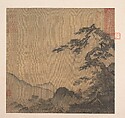Landscape with great pine
Ma Lin Chinese
Not on view
The reductionist transformation from Northern Song monumental landscapes to symbolic images of single rocks and trees is complete with the work of Ma Lin. Ma's painting turns away from the realism of earlier Song Imperial Painting Academy works in favor of a new abstraction. In the absence of an accompanying poem, the meaning of this complex scene remains unclear. The Daoist-inspired imagery seems to hold out the promise of transcendence or escape. Outdoor altars are places of worship and meditation, cranes are known as the vehicles and companions of Daoist immortals, the evergreen pine is an emblem of longevity, and the full moon recalls the palace of the moon goddess, Chang E, whose hare prepares the elixir of immortality. Yet the immortals have not come, and the moon is far away. The figure is anchored to this world and can no more reach the moon than can the outstretched branches of the pine. There is a sense of brooding and foreboding in the tortuous, restless form of the tree that may well be influenced by the impending threat of Mongol invasion.
Due to rights restrictions, this image cannot be enlarged, viewed at full screen, or downloaded.

